The History of the Delta Queen Calliope

(produced by Travis C. Vasconcelos for use as research material on the website www.steamboats.org)
Thomas J. Nichol began his calliope career by developing an idea as to how the whistles of the calliope could be built easier, more efficiently, and save money in the process. Mr. Nichol was the bookkeeper for a Mr. Kirkup of the Van Duzen Bell Works in Cincinnati, OH. (Who it is recorded, built a few calliopes himself in the 1880s’)
Mr. Nichol improved on the idea of calliope whistle construction by employing rolled sheet copper as the basis for his whistles. He also cast his base and cap in brass, for easy and quick construction. The Thomas J. Nichol instruments were famous for the tonal quality of the thinner metal. Sweeter-toned, they were called.
Nichol advertised his calliope business from a warehouse at Pearl and Vine Streets in Cincinnati, OH. where he built standard 18, 21, 24, 28 and later 32-note instruments. Most common requests for new instruments were of the 28-note variety. The largest instrument Nichol ever built was a one-off 37-note job. This instrument did not survive to today.

Of the employees Nichol utilized Mr. Homer Denney of the Coney Island Company was the most noteworthy. Mr. Denney was Calliopist on the Str. ISLAND QUEEN (I and II), and an accomplished musician and musical author. Mr. Denney was employed as the tuner of all new steam calliopes built after 1914 at the Nichol facility. Nichol built over 90 of the 150 or so instruments ever built. After Mr. Nichol’s death in 1924, his sons took over the business. They moved the company to Grand Rapids MI. in 1937. They later renamed the company General Fittings and Devices Co and became a plumbing supply house. Though only entering the business in the last half of the heyday of the calliope, the Thomas J. Nichol instruments are the finest quality, best sounding instruments out there. Of the 12 or so functional originals left all of them (with the exception of one) are Thomas J. Nichol originals.
The family sold the patterns and moulds to a Mr. J. M. Van Splunter who continued building steam calliopes and refitting existing instruments until the early 1960’s for many clients both river and circus related. He did not have patterns for the smallest whistles and many of his refitting jobs were on smaller (21-28 note) instruments to make a full 32 note instrument out of them. When measured, it becomes apparent if he refitted one based on this singular observation.

Vessel built 1925- 1927, Calliope built ?; All facts lead to after 1915.
The Str. Delta Queen was built as a Packet boat on the Sacramento River. She did not feature a steam calliope in this guise, for it was unnecessary to advertise in this fashion for the type of operation she was involved with.
When Capt. Tom R. Greene purchased the DELTA QUEEN in 1946 she was moved to the Ohio and Mississippi River systems and operated as a tourist boat, carrying no freight.
A calliope was first considered for the boat in 1958 when the Simonton and Greene families banded together to continue the operations of the boat. The new Chairman of the Board of Greene Line Steamers, Commander Edwin J. Quinby proposed the calliope to a very reluctant Mrs. Letha C. Greene, President of Greene Line Steamers and the widow of Capt. Tom R. Greene. She felt the calliope would keep the crew awake and be a detriment to the public conception of the boat. Cmdr. E.J. Quinby and Richard Simonton (majority stockholder of Greene Line Steamers) persisted for the calliope.
Simonton had (with the assistance of Quinby and many others) started the American Theatre Organ Society (ATOS) in 1958 and with the lack of space to put one of these instruments aboard their DELTA QUEEN, felt the calliope would become a more proper river-type of ballyhoo instrument for the boat.
Finding the instrument in 1958 was tough for the pair, as no one was building new calliopes at the time. They set out on several leads and most failed them.

This letter from E.J. Quinby to Richard Simonton explains the purchase of the DELTA QUEEN calliope and the efforts to obtain it rather well. This letter comes from the Inland Rivers Collection of the Cincinnati Public Library, Cincinnati, OH.
30 Blackburn Road Summit, NJ. April, 10, 1958
To New Haven and the Branford Electric Railway Saturday April 5th to arrange final preparations for the opening of our 1958 season operations, including the completion of the switches leading to the new car barns, the overhaul of the diesel-electric 600 volt d. c. power plant, the refreshment and souvenir stand, the new picnic grove on the island, (which has required construction of a short entrance causeway across the marshland and felling of a sufficient number of trees to make room for the benches, tables and outdoor fireplaces, and retiring rooms,) tightening up the slack trolley wire, bracing the rail at curves, painting the signals and some maintenance work on the cars. Thence to Waterbury to see a man about a Calliope.
I caught up with one Ellsworth W. (“Slim”) Somers,-a real character. He has a barn full of Calliopes, mostly of the compressed air variety, -albeit he does possess two Steam jobs. He furnishes Calliopes for parades, carnivals, small circuses, celebrations and the like.
Slim has an important job as an executive of the Somers Brass Company in Waterbury, adjacent to his residence. You will no doubt recall that Waterbury is a famous brass town, that it suffered severely from the floods of 1957 on the Naugatuck River which bisects the town, and that it is number one on the list of towns now suffering from unemployment in Connecticut. However, Slim’s plant, on high ground, was unaffected by the floods, and seems to be weathering the slack times very nicely. Slim himself is a Circus Buff, having run away from home and the fireside of a very respectable, aristocratic family at the tender age of 15 to join the circus. His chief hobby today is Calliopes, and of these his first choice is (of course) the steam type. His cousins and his aunts and his brothers and his sisters seem to feel that he should spend less time fooling with his calliope interests and more time as a respectable executive of the Somers Brass Company, but they take an indulgent attitude, since Slim’s mother passed away recently and left most of her money to him! So he can afford the very best cut plug, and chews it incessantly.
Slim’s wife is a rather petite blonde ho, up until the time she married Slim about five or six years ago, -was a Circus Bareback Rider. During the Summer months, she operates a Tourist Attraction at Penn Yan, New York, up in the Finger Lake section, which they call CIRCUSLAND. It is something like Knott’s Berry Farm, only devoted to Circus Lore, and on a somewhat smaller scale, – although it is growing. They have a few elephants, cats, monkeys, trained horses, etc. It is a Mecca for adult Circus Buffs and for any family with kids. Of course they have a calliope there, mounted in a horsedrawn, gawdy circus wagon.
I seemed to get along pretty well with Slim and his wife (her name is CLEONE DULCINIA!)- probably because of my interest in organs, calliopes and steamboats. They of course feel that we should inaugurate a Showboat flavor in the main saloon of the DELTA QUEEN, -which of course is a possibility. As the evening waxed late we drank Scotch Highballs, spun yarns of the circus, the showboat and the calliope. When it came time for me to leave and go to a hotel, they insisted that I tie up with them, – so they gave me a wonderful room with a double featherbed and bath. They have a very lovely, attractive home, with every modern comfort and convenience.
Slim has one Steam Calliope that he wants to keep and operate. The other one (less boiler) is a genuine Thomas J. Nichol job, with sweet-toned copper whistles and he will consider selling it to us. It is the Calliope from a very famous Ohio River Showboat named the WATER QUEEN, which sank in the mouth of the Kanawha River during the 1936 ice-jam. L. Ray Choissier (“Crazy Ray”) was her famous Calliopist and it was he who returned to the scene is 1938 and salvaged this instrument from the sunken WATER QUEEN. It has 32 whistles and balanced valves. The keyboard is new, having been installed by Slim Somers (from a Hammond Organ). These rare whistles are the chief asset. Bottom C is abour 6” in diameter, -not puny like the air jobs.
There were not more than 60 or 70 of these steam calliopes ever built, and this one comes from the most famous builder of them all. While the inventor, Joshua Stoddart, built a few (he patented the thing in 1855), it was Nichols who really made a business of the Steam Calliope at Evansville, Indiana. The original Steam, Calliope has a manifold for the whistles shaped like an A. with the tracker wires leading from the whistles to the keyboard across the open end of the A. Later, a few were built by the Cincinnati Bell foundry, with the whistles mounted in an inverted U shaped manifold. But it was evidently Nichols who produced the design with the whistles mounted on a sort of grid, shaped like the letter H with several cross-bars. The whistles were mounted on six cross-bars, and steam flowed through these cross bar pipes from the two large parallel pipes forming the left and right sides of the H. The keyboard was across the open bottom of the H. This is the design of the Calliope which Slim is willing to sell us. The valves need working over (lapping), as a few leak steam, but this should not be a major undertaking. In fact I would be interested in developing an electro-magnetic action for the valves, for two reasons. First, it would provide fast, snappy action for lively music, and second, it would permit remote location of the keyboard to get the damned Calliopist away from the live steam. The DELTA QUEEN has an ample supply of STEAM as well as an ample supply of DIRECT CURRENT which would be ideal for these solenoid magnets (they would be much heavier and {more} powerful than the little electro-magnets used in organ windchests.) The valve-stem itself could be extended (with ferrous material) to form the armature of the solenoid magnet, which could operate on 110 volt with mercury switches at the keys.
Slim Somers wants $950. for this instrument. He exhibited his records on the job, which reveal that this is exactly the sum which it has cost him to date, including the original purchase price from Ray Choissier (via King Bros. Circus) and the new parts he has made and installed. I don’t think we are in a position to bargain with him for a lower price, because he is reluctant to sell it to ANYONE, except someone who, like us, will really put it to spectacular use. He is apparently comfortably fixed, and does not need the money. Under the circumstances I think he offers it to us for exactly what it cost him, only because he is almost as fascinated with our project as he is with his own hobby. I have asked him to give me an opportunity to take this matter up with you before arriving at a decision, and he agreed.
Let me know how you feel about it. The only other instruments comparable to this that I know of, are in museums like the Ford place a Dearborn, the Marine Museum in Marietta, Ohio or the Cleaver-Brooks at Milwaukee (for the annual Steam Carnival of Steam Tractor Engines, etc.) Do you know of any others?
Bes(t) wishes from Margaret and myself to both of yez. Hope to hear from you soon by mail or direct hook up!
73, Jay

This is where the calliope came from for the DELTA QUEEN. However, the mentioning of the calliope being that of the Showboat WATER QUEEN has faced some scrutiny in recent years. The calliope can be traced accurately to “Slim” Sommers however; this WATER QUEEN business is very suspect. In a photograph (below) supplied by Capt. Clarke Campbell “Doc” Hawley of New Orleans, LA. the WATER QUEEN showboat calliope is definitely a 28-note instrument. The DELTA QUEEN calliope is a 32-note instrument. The WATER QUEEN calliope is of construction dating before 1914 as the threaded rods supporting the whistles are of a pointed top nature, something Nichol only did before 1914. The DELTA QUEEN calliope in contrast has rounded tops on her threaded rods. This would indicate construction after 1914.

So we are now faces with the question where did the DELTA QUEEN calliope come from. Due to the fact Thomas J. Nichol never dated or placed serial numbers on his instruments, we may never know the true derivation of this instrument. Most likely one could conclude, it has origins from a circus show. If this is true, which one we will never know.
Sheppard Laboratories with Cmdr. E. J. Quinby and Peter Dykema built a manifold for the whistles and assembled the job for installation aboard the DELTA QUEEN in January 1960. Chief Engineer Cal Benefiel was the first person to activate one of the whistles from the keyboard. Cmdr. Quinby played “My Old Kentucky Home” as the first June. Later in April of 1960 a Decca recording was made of Cmdr. Quinby and Capt. Billy Menke playing the calliope.
The calliope became a sensation due to the advertising talents of Cmdr. Quinby. He would sport a Prince Albert coat, Top Hat and carry a silver-headed cane as he strode from the calliope to the public on the landing, there he would pass out flyers about the DELTA QUEEN and river cruises. This sold many a cruise to the public!
The DELTA QUEEN calliope went through many adjustments in the early years. A pedal was supplied to adjust the pressure of the steam electronically. The idea was to replace the fade in and fade out produced by mechanical means of playing the calliope. The pedal was removed in the late 1960’s, as it never seemed to work as planned. The “Aurora Effect” of coloured lighting behind the whistles has stayed and been quite popular to this day.

In 1970 a Una-Fon was added to the calliope by Arthur Davis, an electronics engineer consulted by Quinby and Simonton for work on the calliope. A Una-Fon is a set of xylophone bell strips activated by a reiterating magnetic hammer. This electronic bell-ringing device was wired similar to a pipe organ and was not suited for outdoor use. It was removed in 1985, failing to operate reliably after 1976. The effect of the two barely tunable instruments in competition with each other was a cacophonic nightmare of sound. You either liked it or hated it, there was no in between.
The DELTA QUEEN calliope of today is essentially the same calliope as has been aboard the vessel for the last 45 years. However, the “C”# (Whistle No# 2) above the bottom “C” has been removed and presented to Capt. Gabriel Chengery as a 25th anniversary of his employment with the company. It was replaced by a whistle built by David Morecraft of Peru, IN. and is indistinguishable from the rest of the set.
In 2000 Mike Neidorf, Second Engineer of the DELTA QUEEN built a new manifold and addressed the problem of condensate the calliope has. With the addition of two steam traps and elevating the middle of the manifold, this has addressed the situation quite well.
At this time a new electronics package was added by Dr. Don Elbers of Mandeville, LA. Dr. Elbers, a Theatre Organ specialist, used a wooden pipe organ keyboard with feather switch gear and relays (a type of electronics kit proprietary to the indoor pipe organ application). This has had profound effect on the playability of the calliope as humidity and wet weather can leave the keyboard useless for days at a time and the relay system slows down the action considerably. It is notable he retained the Magnatrol valves which are the best suited valve for calliope operation of the electronic type.
On 3, May 2008 Zachary Morecraft (son of David Morecraft, the last authentic steam calliope builder in the world) and myself inspected the calliope of the DELTA QUEEN and Zach noticed something which has eluded historians for years about the DELTA QUEEN calliope. Although the 28 notes which could have come from the WATER QUEEN were infact measurable correctly in the set, there were 4 suspect whistles. Upon careful inspection it was determined 4 whistles were sourced from J.M.Van Splunter. Whistle #30 (high “F”) is most definitely produced by Mr. Van Splunter. This would lead one to believe the WATER QUEEN calliope is infact aboard the DELTA QUEEN.

The reader of this writing will have to decide for him or herself the origins of the DELTA QUEEN calliope based on this manuscript. As the author, I have researched and documented my findings with no possible conclusion. Perhaps as others read this document, memories of stories told will ring true with the words here in and cause a memory to come which may solve this dilemma.

Research for this document utilized the following
• Showboats, 1951 Phillip Graham, University of Texas Press • Moonlight at 8:30, 1994 Captain Clarke Campbell “Doc” Hawley and Captain Alan Bates, Art-Print and Publishing Company Louisville, KY. • Steamboat Calliopes, 1980, Les Swanson, Self-Published • Various conversations with Authors herein mentioned and Captain C.W. Stoll, Jane Greene, David Morecraft, Les Swanson, Larry Mac Pherson, and other very knowledgeable calliope aficionados.
Document produced by Travis C. Vasconcelos for use as research material on the website www.steamboats.org
At this time the author would like to apologize to all readers for any omissions to the story or any error herein included. In the many years of calliope research I have found dead ends and also somewhat grotesque embellishments on the story of the DELTA QUEEN calliope, many of which have been accepted as fact. I have attempted to utilize only documentable fact in the creation of this document. If for some reason this is not the true fact I stand before you humbled once you provide documentation.
It is requested this material and the photographs included not be reproduced in any form with out the written consent of the site manager of the website www.steamboats.org and/or the author (Travis C. Vasconcelos). If written consent is given it will require citation indicating the location of the finding and sourcing of the information.
Privacy Overview

- Complimentary Planning Assistance
- Destination Wedding Guide Digital Copy
- Elopement Packages
- Marriage License & Legal Essentials
- Welcome Bag Ideas
- Second Lines
- The History of Wedding Umbrellas and More in New Orleans
- Wedding Cake Pulls
- Destination Wedding Guide Printed Copy
- Wedding Inspiration
- Wedding and Event Planners
- Photographers & Videographers
- Transportation
- Beauty, Hair & Makeup
- Spas, Health & Wellness
- Cakes & Bakeries
- Entertainment
- Engagement Photos in New Orleans
- Bridal Shower & Brunch
- Joint Bachelor/ Bachelorette Parties
- Bachelor Parties
- The Ultimate New Orleans Bachelorette Party Guide
- Honeymooning
- LGBTQ Bachelor / Bachelorette Party Itinerary
- Walkable Downtown
- Corporate Group Incentive
- LGBTQ New Orleans
- Convention Center
- Caesars Superdome
- Smoothie King Center
- Special Events Venues
- Hotels with Meeting Space
- Venue Search
- Custom Maps
- Services Directory
- Convention Services Request
- Exhibitor Services Request
- Custom Post Cards & Save the Date
- New Orleans Print Materials Request
- Visitor Guide Request
- Corporate Social Responsibility & Donations
- Emergency Planning
- Meeting Planner Guide
- Transportation Directory
- Transportation & Getting Around
- Promotional Videos & Images
- Stats and facts
- Free Things To Do
- Talk like a New Orleanian
- Local Outreach
- Social Media Resources
- Marketing e-Templates & Ads
- Convention Calendar
- Testimonials
- Submit Your Request for Proposal (RFP)
- Availability Grid
- Coupons Deals
- Group Transportation
- Assistance Request
- Bulk Brochure Request
- Photos & Videos
- Microsite Request
- Itineraries
- Performance Venues
- Motorcoach/Group Transportation
- Educational Opportunities
- Student Itineraries
- voluntourism
- Class Reunions
- Venue & Services
- Hotel Assistance
- Promote Your Reunion
- Family Reunions
- Military Reunions
- Regulations and Maps
- Motorcoach Parking
- Tax Free Shopping
- International Travel Tips
- Consulates in New Orleans
- Maps & Transportation
- Advisor VIP Pass
- Brochure Request
- Photos/Videos
- Cruise Coupons
- Pre-Post Packages
- General Coupons
- Voluntourism
- Group Travel Planner Guide
- Travel Advisor Certification
- International Groups
- Group Travel
- Cruise Lines
- Meet the Team
- Did You Know | New Orleans Facts
- Member Benefits
- Maximize Your Membership
- Application NOT USED
- Membership Policies
- Member Directory
- Company Stats & Facts
- Event Photos
- Member Anniversaries
- New Members
- Member Login
- Media Assistance Request
- What's New in New Orleans
- New Orleans Awards & Accolades
- Image Library
- B-roll Assets
- New Orleans & Company Press Releases
- Hospitality Industry Press Releases
- Image / Video Request
- Communications & PR Contacts
- New Orleans Festivals And Events
- French Quarter
- A Guide to New Orleans Nightlife
- Attractions
- Cultural Arts
- Mystical/Haunted New Orleans
- Family-friendly Guide to New Orleans
- Multicultural
- Recreation & Outdoors
- Architecture
- Find Restaurants
- Where to Eat
- Traditional Foods
- Top Chefs In New Orleans
- Restaurant Deals
- Love To Eat Video Series
- Find a Place to Drink
- Where to Drink
- Classic New Orleans Cocktails
- Book a New Orleans Hotel
- Hotel Directory
- Bed And Breakfasts: Hotels - New Orleans & Company
- Saint Charles Avenue Hotels
- Luxury Hotels
- Garden District Hotels
- French Quarter Hotels and Lodging
- Downtown/Central Business District Hotels and Lodging
- Bourbon Street Hotels
- Green Hotels
- Bourbon Street Balcony Hotels - New Orleans & Company
- Haunted Hotels in New Orleans
- Pet-Friendly Hotels
- Historic Hotels
- Upcoming Events
- Ultimate New Orleans Event Calendar
- New Orleans LIVE Music Calendar
- Submit an Event
- Major Events and Festivals in New Orleans
- New Orleans Neighborhood Guide
- Streets to Visit
- Request a Guide
- Deals & Coupons
- Essential New Orleans Three-Day Itinerary
- Bleisure Itinerary
- Monthly Newsletter
- Insider's Blog
- Virtual Tour
- Accessibility
- New Orleans Artist Database
- LOVENOLA.TV 24/7 Broadcast

The Calliope on Steamboat Natchez
The delightful sounds of the steam organ travel along river neighborhoods.
It happens almost every day around 11 a.m. and again later in the afternoon. Visitors strolling the streets of the Vieux Carré stop dead in their tracks, cock their heads toward the river and wonder, “Where’s that strange music coming from?” The most curious among them follow the loud yet breathless sounds of the whistle to the Toulouse Street Wharf where they can then see bursts of steam erupting from the calliope on the Steamboat Natchez. Synchronized colored lights dance along with each note.
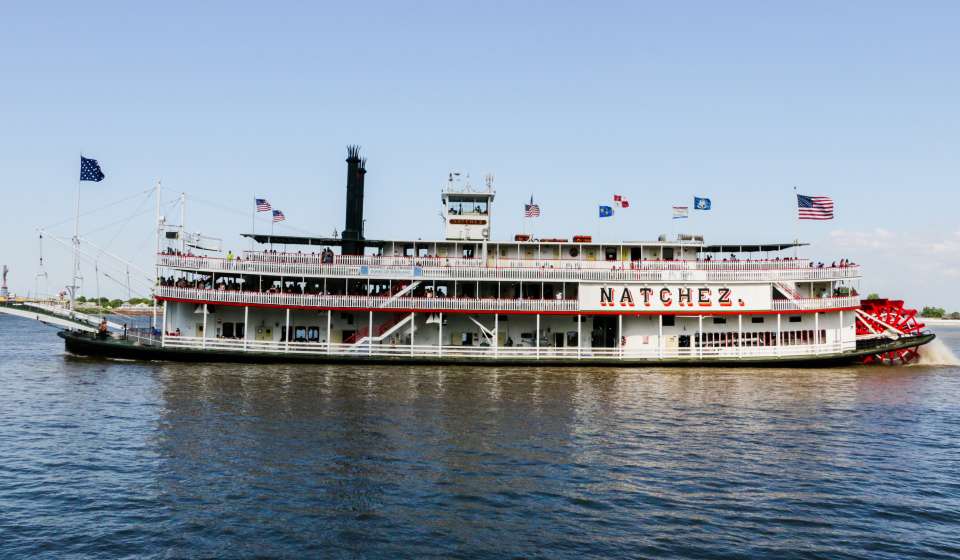
The steam calliope, a steam pipe organ, has been identified with steamboats since 1865. Even small calliopes can be very loud and can be heard for miles. It was once a signal to head for the river: A showboat was ‘a comin’. Now it fills the French Quarter and beyond with its melodious peals reminding visitors and locals that steamboats still ply the Mississippi. So grab a seat on a bench in Woldenberg Park and enjoy the free show.
- Things to Do
- Trip Planning Tools
- Meeting Planners
- Travel Professionals
- Press and Media
- Privacy Policy
- Site Search
- Doing Business in New Orleans
- About NewOrleans.com
- Report Fraud
- Accessibility Options

Sign up for special tips, offers, and info about all the latest happenings around NOLA with our monthly Insider’s Guide, delivered right to your inbox.
- NKY COMMUNITY CALENDAR

I informed my friend that “the last time Homey Denney played the calliope onboard the DELTA QUEEN, he played for me.” (Bert Finn Photo)
Back in that year, the QUEEN found herself snoozing at the Public Landing for a couple of days between trips. Most of the crew hailed from “Ragtown,” as Cincy was known during the steamboat era for rag bales arriving by the zillions on the busy packets. As soon as the last line ran ashore, and as fast as each crewman and woman could desert the boat like rats abandoning a doomed ship, they did… including Captain Ernest E. Wagner, the Master, who fled to nearby New Richmond, upstream a few miles, and left me to watch the DELTA QUEEN until he returned.
It was a lazy afternoon when I answered a knock on my three-by-seven-foot “stateroom” door, and the college kid working as a Watchman for the summer announced:

Grandma Edith heard many played in her time growing up around the river in the late 19th and early 20th centuries when she knew the various steamboats by the sounds of their whistles.
“There’s some old dude down on the bow who wants to play the calliope.”
Just as I was about to bust out in mocking laughter, a better voice in the back of my mind caused me to ask:
“Did he give his name?”
“Yeah… Benny, Skinny, Vinnie… something like that?”
Again that better voice thought and asked:
Denney… Denney? Homer Denney, perhaps?”
“Yeah, that’s it… Homer Denney.”
The General Alarm Bells inside my head immediately replaced the “better voice,” and I scrambled into my shirt and shoes before Mr. Denney changed his mind and left the boat. As I tore out of my suite and ran for the bow, I thought enough to swing by the Purser’s Office where Chief Purser Gabriel Chengery happened to be and alerted Gabe that we had an illustrious visitor aboard.
Today, everyone remembers Gabe as “Captain Gabe,” one of the longest-serving and most-capable captains on the DELTA QUEEN and MISSISSIPPI QUEEN steamboats. In 1970, Gabe was in the purser’s office keeping track of the DELTA QUEEN’s money and whatever-else pursers did after the days when the “Clerk” kept track of the cargo and livestock of the two and four-footed varieties. Gabe played the steam calliope and was also an avid fan of the accomplishments of Mr. Denney and his contributions to the multi-whistled musical instrument my granny, Edith LaVelma, called a “Calley-O;” not a “calliope.”
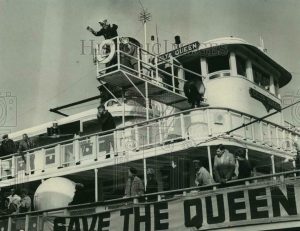
Captain Ernest E. Wagner fled to nearby New Richmond and left me to watch the DELTA QUEEN until he returned.
Grandma Edith heard many of them played in her time growing up around the river in the late 19th and early 20th centuries when she knew the various steamboats by the sounds of their whistles.
By the time I introduced myself to the elder steamboat statesman and had him seated at the QUEEN’s version of the “infernal music machine,” Gabe had the steam cranked on high and collected a few more fans for the maestro’s final presentation at the brass calliope keyboard. During the impromptu concert, Gabe made an audiotape recording, and I shot 35mm black and white photos as the old gentleman resurrected the tunes he’d been playing on numerous steam-powered musical machines since he began playing on the first ISLAND QUEEN in the early days of the 20th Century. Many years later, I found the undeveloped film in the abandoned camera and failed to realize it recorded the Denney presentation until the prints returned from the developer. I wonder, now, if Captain Gabe still has the recording of Professor Homer Denney’s last time he played the Thomas J. Nichol steam-powered Calley-O onboard the DELTA QUEEN? Gabriel?
Of course, my friend had to counter my calliope story with another of his own:

In 1970, Gabe was in the purser’s office keeping track of the DELTA QUEEN’s money.
It was around the last of winter, possibly during March of 1960, when the “genuine Thomas J. Nichol job, with sweet-toned copper whistles” was new aboard the DELTA QUEEN following the acquisition and installation by Commander E. Jay Quinby, Chairman of the Board of Greene Line Steamers, Inc., owners of the QUEEN. The DELTA QUEEN was wintering at the Greene Line wharfboat. Keeping her company on the downstream end of the floating wharf was the Steamer AVALON, the last tramping excursion steamboat, which, within two years, would become the Steamer BELLE of LOUISVILLE, now, 61 years later, still operating and soon to be in her 107th year of continual service.
Although the AVALON was “cooled down,” the small, auxiliary, or “donkey” boiler spouted a full head of steam. The coal-fired boiler had enough vaporous energy to spin the capstan, lift the stage, and operate the main boilers’ fuel pumps until they came online. The donkey boiler also possessed enough potency to power the calliope high on the roof behind the pilothouse.
Seated aft, one deck below the DELTA QUEEN roof, Professor Quinby belted out a tune on his newly-acquired musical instrument to show off its ability to generate raucous, cacophonous, and melodious reverberations. As soon as Quinby finished the first song, the calliopist aboard the AVALON answered in return. Soon, one tune after another echoed among the high hills on either side of the Ohio River Valley until it seemed, as one witness observed:
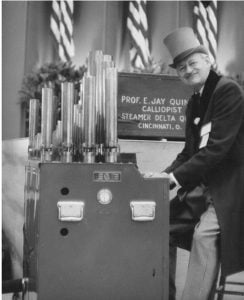
Commander E. Jay Quinby, chairman of the board of Greene Line Steamers Inc., owners of the DELTA QUEEN. (Wm. Muster photo)
“The reverberating notes appeared to drown out each other.”
By then, those aboard the AVALON feared the continuous competing of the dueling calliopes would soon lay waste to the smaller boat’s reserves of precious coal reserves. So the tramp excursionist signaled default with a final cessation of notes musicians sometimes call “over the fence and out.” Not being musically inclined, myself, I harken the expression to mean what John Hartford called, “a shave and a haircut.”
With the AVALON out of the show, Mr. Quinby finished one last melody aboard the DELTA QUEEN, and all was quiet between the steamboats.
Suddenly and unexpectedly, a third calliope shattered the silence. Overtopping the Public Landing, the piercing tones blasting from the brass whistles of an air-powered calliope on a circus-style wagon filled the atmosphere barely recovered from the combined wails of the two steam-operated machines. To the trained ear, the tonal technique of the mysterious newcomer possessed a familiar air. Within minutes, the stranger’s identity was soon revealed. It was none other than Professor Homer Denney tickling the keys on the air-powered calliope to join in the celebration for the acquisition of the new steam-calliope onboard the Steamboat DELTA QUEEN.
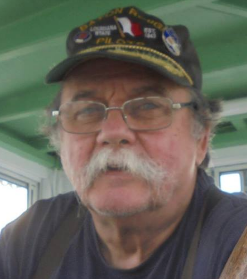
Related Posts

Chef, reputation got Keyhole Bar & Grill a catering gig for visiting teams at Great American Ball Park


Opinion – Al Cross: The political life and lessons of George Atkins, who died April 14 at age 82

Thomas More University honors three during annual Bishop William A. Hughes Award Dinner

13 Comments
Leave it to Captain Sanders’s to peak my interest in a tale from the past….. Thanks Cappy!
What an awesome story! Thanks so much!
Great story, Capt! Keep them coming!!
Another great story for the record books. Thanks and keep ’em coming!
Cap’n Don does a fabulous job painting pictures with his pen and words..Good stuff trhat I look forward to reading
Air just doesn’t sound as Good as Steam. I’m no expert on Calliopes, but I know the difference in Whistles.
Well written. I love to hear those stories.
One more fine tale from a fine story teller. A great read, as usual
Thank You, Capt. Sanders. You bring back great memories of my childhood. I lived on Bakewell Street in Covington and every summer night while we sat in the side yard and the Island Queen was at Dock on the Ohio river we enjoyed the calliope music. I was about 10 or 12 years old when the Island Queen burned for the second time. Several years ago I took a tour on the Mississippi Quee out of New Orleans and once again enjoyed the Calliope. Can’t wait for your next story.
Another great story from the master….Thank you so much for this story Captain Santers…..Your writing makes me feel like I am back there listening to those musical notes. Since I live in the French Quarter of NewOrleans I find myself on my courtyard balcony often listening to those musical notes coming with the breezes.
Wow! That was a good’un Cap’t Don! I sure am glad you’re writing down all these Memories. Maybe they need to go in a book somehow…
Thanks Capt Don. You yet again bring people, places and memories alive for us of that day or introduce them to new river folk. Please keep them coming and I hope a book is coming soon.
Thanks, everyone for your comments. I must dig out those old photos of Professor Homer Denney tootin’ the DQ calliope. Hopefully, Cap’n Gabe still has the audio recording.
Leave a Comment Cancel Reply

Affiliations
- Licking River Series

- Boats & Barges
- Ports & Terminals
- Legislative/Regulatory
- Dredging & Marine Construction
- General News
- WJ Editorial
- Old Boat Column
- About Waterways Journal
- Subscribe Today
- Digital Edition
- Inland River Guide
- Inland River Record
- IDR Annual Directory
- Inland Marine Expo
- Special Events
- Help Wanted
- Situations Wanted
- Floating Equipment for Sale or Rent
- Boats, Barges Wanted
- Miscellaneous for Sale
- Miscellaneous Wanted
- Public Notices
- Professional Directory
- Real Estate
- Business Opportunity
- View All Categories
- Submit a Classified Ad
- 2024 Inland River Record
- 2024 Inland River Guide
- 2023 IDR Annual Directory
- View All Products
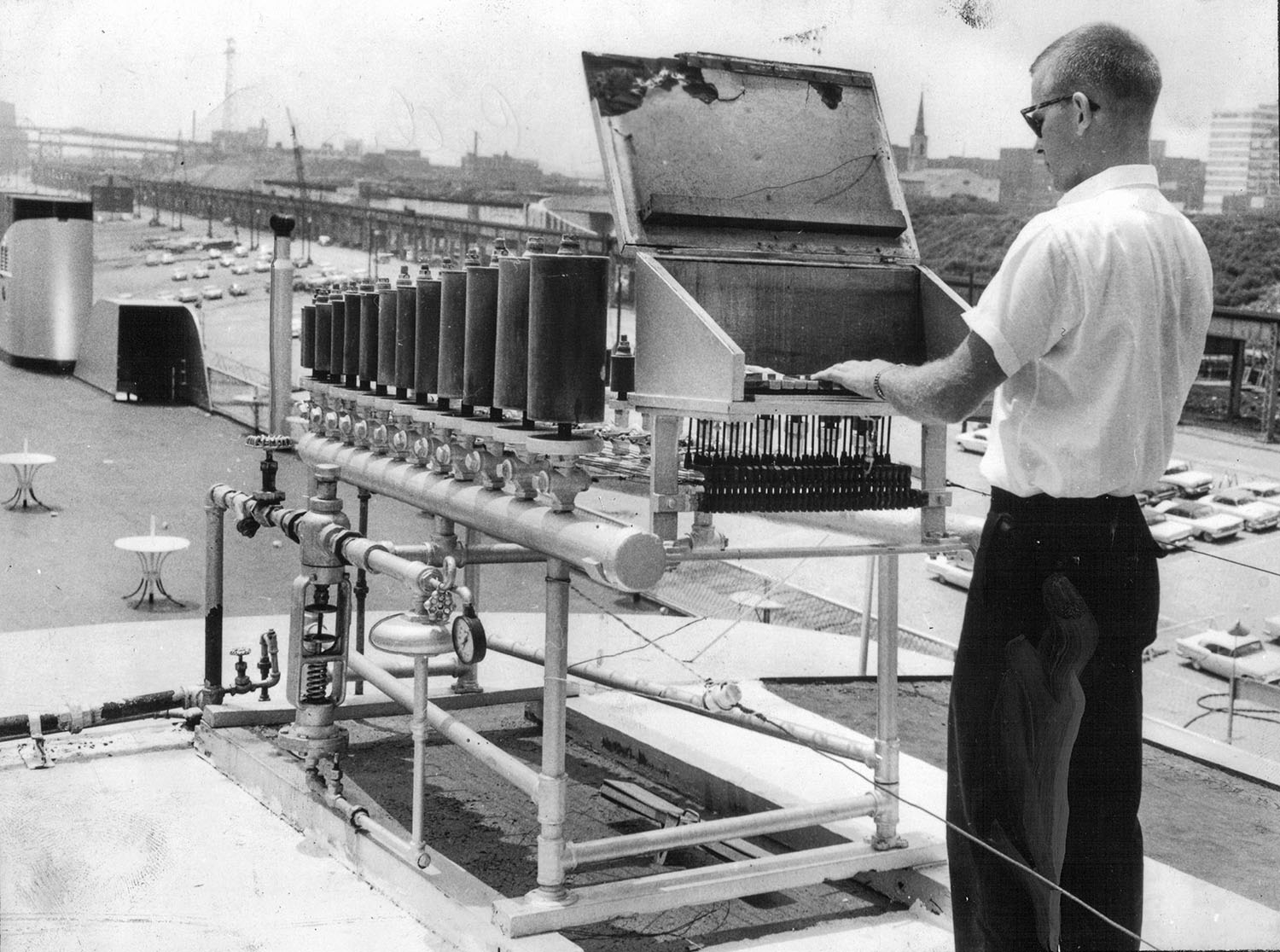
The Calliope Of The Capitol
The passing on July 14 of Capt. Bill Streckfus at age 88 brings to mind that he took special interest in maintaining the 32-note Nichol calliope that was perched high on the roof of the S.S. Admiral. Over the years there has been considerable controversy as to the origin of the instrument. However, a 1964 interview of the father-son team of Capts. Roy and Bill by a St. Louis Post-Dispatch writer should provide adequate information to close the case.
Capt. Roy, who grew up hearing calliope music from the various boats owned by his family, authoritatively said, “The calliope on the Admiral came off our old steamer, the Capitol, which worked the excursion trade from St. Paul to New Orleans. “The calliope was the main way we had to advertise that the boat was coming to town. We’d open the concert with “Happy Days Are Here Again” and pull them down out of the hills!”
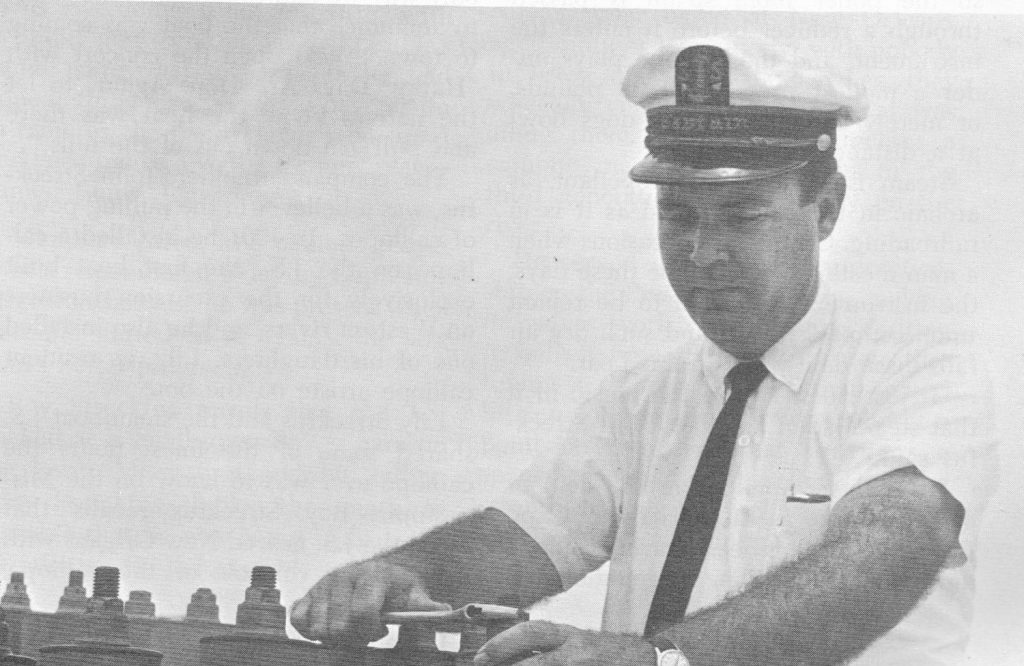
The Streckfus Line purchased the big sternwheeler Dubuque in 1910 and continued packet service until 1917, making a charter trip in the spring of 1912 to the Shiloh Battlefield for the St. Louis & Tennessee River Packet Company. In November of 1914, Capt. Charles Martin, pilot, died at the wheel as the boat approached the railroad bridge at Alton, Ill. The engineer on watch noticed the boat veering off course, stopped and quickly backed full, averting tragedy. The off-watch pilot, Capt. Jack Richtman, was quickly summoned to the pilothouse as the trip safely resumed.
During the winter of 1919–20, the boat was taken to Keokuk, Iowa, for renovations, with the work completed at Davenport. The boat was renamed Capitol, the staterooms were removed to make room for excursionists and four new boilers were installed. The sternwheel was modified to measure 25 feet in diameter with 30-foot bucket planks having a dip of 24 inches. The pitmans were 24 feet long. There were four main rudders with two monkey rudders (aft of the wheel) to aid in steering the sternwheeler.
From 1920 until 1941, the Capitol traversed the Mississippi from St. Louis to St. Paul, usually wintering in New Orleans. The boat was a favorite of Rock Island, Ill., resident Walter Patsch, late father of Upper Mississippi River historian Judy Patsch.
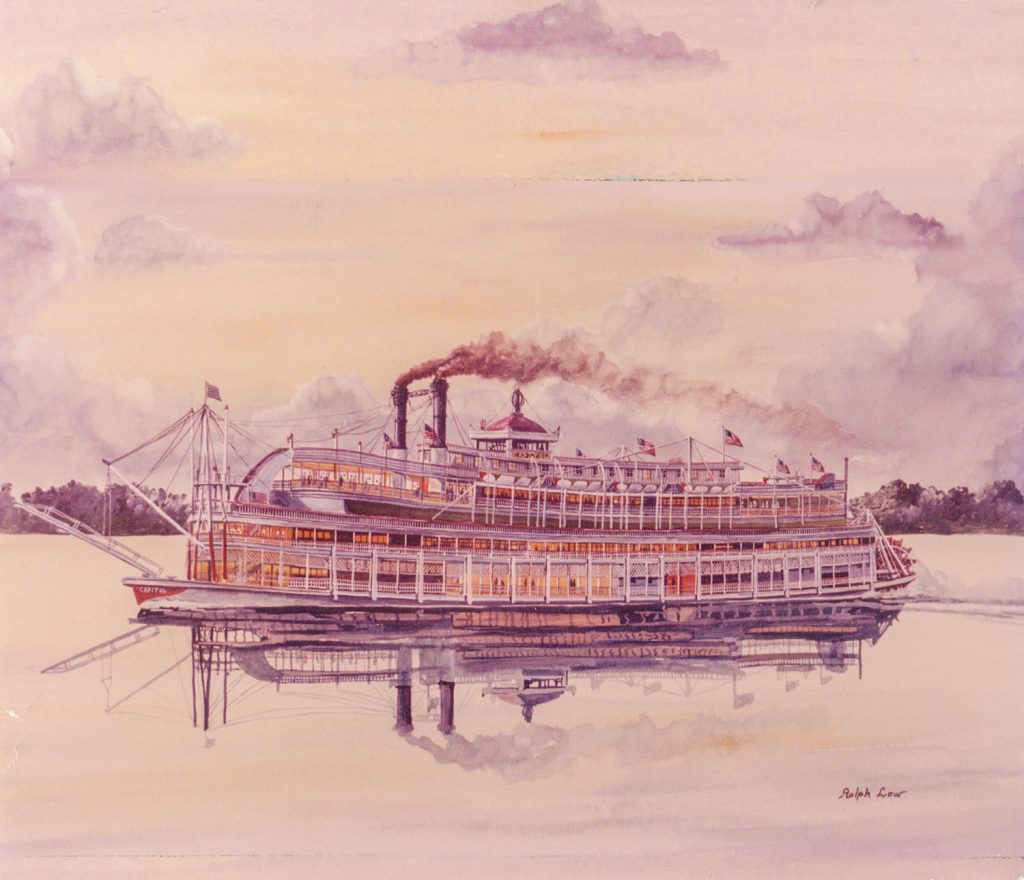
With Capt. Roy long its master and after a safe and fruitful career (with growing concern for the waterlogged hull) the popular riverboat was retired, dismantled and scrapped in 1945 at the St. Louis levee. This writer prizes a small section of jigsaw railing (with many coats of white paint!) that was rescued by river historian Ruth Ferris (1897–1993) who recalled many stacks of the decorative wooden steamboat trim piled high on the levee.
The writer heard the calliope played at the levee several times but never had the opportunity to play it.
In the 1980s, during the tenure of the late Capt. Bill Carroll, the steam organ was removed, by helicopter, from the Admiral and was said to have been placed into storage. Riverboat enthusiasts are reportedly still trying to locate it. The Capitol’s large pilotwheel and the pitmans from the Admiral are displayed at the National Museum of Transportation in St. Louis.
Caption for top photo: The steam calliope from the Capitol atop the S.S. Admiral in 1962. (Keith Norrington collection)

- Bill Streckfus
- steamboat calliope
- Streckfus Steamers

Trending Now
- 40 Under 40 Award Recipients Announced For 2024
- First Concrete Pour Completed At Demopolis Lock
- Campbell Transportation Renames Towboat After CFO’s Wife
- Intense Rain Causes Flooding On Upper Ohio
- Barges Remain Pinned On Dams Following Upper Ohio Breakaway
- He Walked On Water From Cincinnati To New Orleans

IMAGES
VIDEO
COMMENTS
The Calliope is pronounced "kally-ope" by circus people, but on the river it's usually pronounced "kal-eye-o-pee". Patented in October 1855, its inventor, Joshua C. Stoddard, intended to use this instrument in a church. Soon the calliope found its way to the circus and especially to the floating showboats on the Lower Mississippi River.
The DELTA QUEEN calliope is a 32-note instrument. The WATER QUEEN calliope is of construction dating before 1914 as the threaded rods supporting the whistles are of a pointed top nature, something Nichol only did before 1914. The DELTA QUEEN calliope in contrast has rounded tops on her threaded rods.
A calliope (see below for pronunciation) is an American and Canadian musical instrument that produces sound by sending a gas, originally steam or, more recently, compressed air, through large whistles —originally locomotive whistles. A calliope is typically very loud. Even some small calliopes are audible for miles.
It all started with a query directed to Travis C. Vasconcelos, a long-time steamboat fellow, calliope player, riverboat historian, and presently the Curator of the Howard Steamboat Museum in ...
Natchez Steamboat. The steam calliope, a steam pipe organ, has been identified with steamboats since 1865. Even small calliopes can be very loud and can be heard for miles. It was once a signal to head for the river: A showboat was 'a comin'. Now it fills the French Quarter and beyond with its melodious peals reminding visitors and locals ...
Delta Queen Calliope Music played by Rosalinda DeLeon at the start of the June 2006 Great Steam boat race from Baton Rouge LA to St. Louis MO. I have more i...
Mention the history of the steam calliope played on showboats and passenger boats on the Mississippi River System during the past 150 years, and "Professor" Homer Denney's name will be ...
The steamboat also featured a 44 whistle steam calliope, which was the largest on the Mississippi River system. The Mississippi Queen was laid up in New Orleans at Perry Street Wharf after being gutted, initially for renovation. Instead, however, the steamboat was sold for scrap in May 2009. ...
Pierre Repooc Productions - URL:http://www.youtube.com/c/PierreRepoocAt disembarkation, it is tradition to play the Calliope on the "American Queen", the lar...
50K views, 505 likes, 106 loves, 156 comments, 523 shares, Facebook Watch Videos from WWLTV: New Orleans is a city of sounds, and one of them has been around for almost 200 years: The Calliope. Sounds of New Orleans: The Riverboat Calliope | New Orleans is a city of sounds, and one of them has been around for almost 200 years: The Calliope ...
Here I'm playing the steam driven calliope on the roof of the riverboat Nachez in New Orleans.The tune is "Waiting for the Robert E. Lee". Words by L. Wolfe...
Riverboat enthusiasts are reportedly still trying to locate it. The Capitol's large pilotwheel and the pitmans from the Admiral are displayed at the National Museum of Transportation in St. Louis. Caption for top photo: The steam calliope from the Capitol atop the S.S. Admiral in 1962. (Keith Norrington collection)
A model of the riverboat Natchez is displayed in the French Quarter home of the Natchez's captain and calliope player, Clarke "Doc" Hawley, on July 5, 2017. FILE PHOTO BY CHERYL GERBER Facebook
Debbie plays the calliope daily at 10:45 a.m., 1:45 p.m., and 5:30 p.m. aboard the Steamboat Natchez. In addition to playing on the Steamboat Natchez, she's the musical director at Our Lady of ...
Steam-powered calliope "music" from The Natchez riverboat moored on the Mississippi River in New Orleans' French Quarter tourist district. The little girl ho...
Goritsy, a farming settlement on the Sheksna River, and Kirillov, which may be small but has extraordinary churches linked to the tsars. Choice of A visit to Saint Cyrill on the White Lake Monastery-OR- Goritsy "Village Day" Later, relax onboard as your ship cruises through the second-largest lake in Europe. Fed by 58 rivers, Lake Onega has ...
Several Glen-L Boatbuilder Forum members attending the annual Glen-L Boatbuilder Gathering in Guntersville, Alabama met up at the Delta Queen Riverboat, moor...
The Moscow Variation (also known as the Canal-Sokolsky Attack) is one of the most popular "Anti-Sicilians), and a great way to avoid tons of main line theory...
Legendary 1949 Moscow concert
This video shows a breathtaking scenery of Moscow city from a Cruise.. I enjoyed the boat ride for 2 hours.. Moscow river cruise is one of the best excursion...